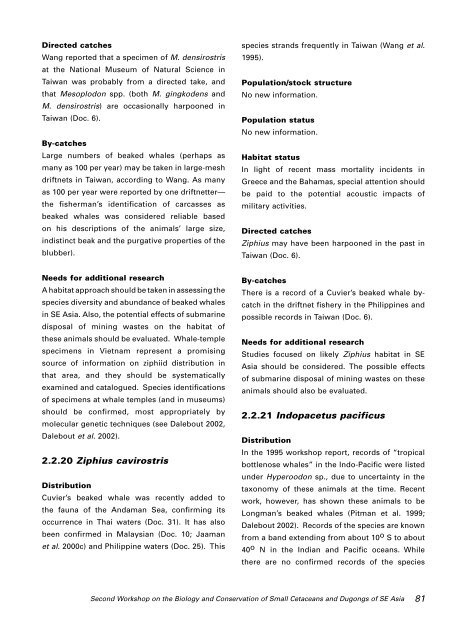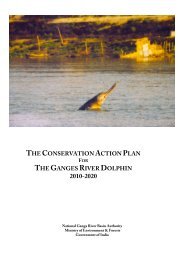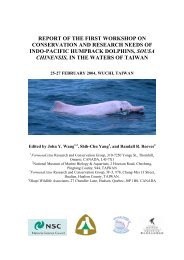Report of the Second Workshop on The Biology and Conservation of ...
Report of the Second Workshop on The Biology and Conservation of ...
Report of the Second Workshop on The Biology and Conservation of ...
You also want an ePaper? Increase the reach of your titles
YUMPU automatically turns print PDFs into web optimized ePapers that Google loves.
Directed catchesWang reported that a specimen <str<strong>on</strong>g>of</str<strong>on</strong>g> M. densirostrisat <str<strong>on</strong>g>the</str<strong>on</strong>g> Nati<strong>on</strong>al Museum <str<strong>on</strong>g>of</str<strong>on</strong>g> Natural Science inTaiwan was probably from a directed take, <strong>and</strong>that Mesoplod<strong>on</strong> spp. (both M. gingkodens <strong>and</strong>M. densirostris) are occasi<strong>on</strong>ally harpo<strong>on</strong>ed inTaiwan (Doc. 6).By-catchesLarge numbers <str<strong>on</strong>g>of</str<strong>on</strong>g> beaked whales (perhaps asmany as 100 per year) may be taken in large-meshdriftnets in Taiwan, according to Wang. As manyas 100 per year were reported by <strong>on</strong>e driftnetter—<str<strong>on</strong>g>the</str<strong>on</strong>g> fisherman’s identificati<strong>on</strong> <str<strong>on</strong>g>of</str<strong>on</strong>g> carcasses asbeaked whales was c<strong>on</strong>sidered reliable based<strong>on</strong> his descripti<strong>on</strong>s <str<strong>on</strong>g>of</str<strong>on</strong>g> <str<strong>on</strong>g>the</str<strong>on</strong>g> animals’ large size,indistinct beak <strong>and</strong> <str<strong>on</strong>g>the</str<strong>on</strong>g> purgative properties <str<strong>on</strong>g>of</str<strong>on</strong>g> <str<strong>on</strong>g>the</str<strong>on</strong>g>blubber).species str<strong>and</strong>s frequently in Taiwan (Wang et al.1995).Populati<strong>on</strong>/stock structureNo new informati<strong>on</strong>.Populati<strong>on</strong> statusNo new informati<strong>on</strong>.Habitat statusIn light <str<strong>on</strong>g>of</str<strong>on</strong>g> recent mass mortality incidents inGreece <strong>and</strong> <str<strong>on</strong>g>the</str<strong>on</strong>g> Bahamas, special attenti<strong>on</strong> shouldbe paid to <str<strong>on</strong>g>the</str<strong>on</strong>g> potential acoustic impacts <str<strong>on</strong>g>of</str<strong>on</strong>g>military activities.Directed catchesZiphius may have been harpo<strong>on</strong>ed in <str<strong>on</strong>g>the</str<strong>on</strong>g> past inTaiwan (Doc. 6).Needs for additi<strong>on</strong>al researchA habitat approach should be taken in assessing <str<strong>on</strong>g>the</str<strong>on</strong>g>species diversity <strong>and</strong> abundance <str<strong>on</strong>g>of</str<strong>on</strong>g> beaked whalesin SE Asia. Also, <str<strong>on</strong>g>the</str<strong>on</strong>g> potential effects <str<strong>on</strong>g>of</str<strong>on</strong>g> submarinedisposal <str<strong>on</strong>g>of</str<strong>on</strong>g> mining wastes <strong>on</strong> <str<strong>on</strong>g>the</str<strong>on</strong>g> habitat <str<strong>on</strong>g>of</str<strong>on</strong>g><str<strong>on</strong>g>the</str<strong>on</strong>g>se animals should be evaluated. Whale-templespecimens in Vietnam represent a promisingsource <str<strong>on</strong>g>of</str<strong>on</strong>g> informati<strong>on</strong> <strong>on</strong> ziphiid distributi<strong>on</strong> inthat area, <strong>and</strong> <str<strong>on</strong>g>the</str<strong>on</strong>g>y should be systematicallyexamined <strong>and</strong> catalogued. Species identificati<strong>on</strong>s<str<strong>on</strong>g>of</str<strong>on</strong>g> specimens at whale temples (<strong>and</strong> in museums)should be c<strong>on</strong>firmed, most appropriately bymolecular genetic techniques (see Dalebout 2002,Dalebout et al. 2002).2.2.20 Ziphius cavirostrisDistributi<strong>on</strong>Cuvier’s beaked whale was recently added to<str<strong>on</strong>g>the</str<strong>on</strong>g> fauna <str<strong>on</strong>g>of</str<strong>on</strong>g> <str<strong>on</strong>g>the</str<strong>on</strong>g> Andaman Sea, c<strong>on</strong>firming itsoccurrence in Thai waters (Doc. 31). It has alsobeen c<strong>on</strong>firmed in Malaysian (Doc. 10; Jaamanet al. 2000c) <strong>and</strong> Philippine waters (Doc. 25). ThisBy-catches<strong>The</strong>re is a record <str<strong>on</strong>g>of</str<strong>on</strong>g> a Cuvier’s beaked whale bycatchin <str<strong>on</strong>g>the</str<strong>on</strong>g> driftnet fishery in <str<strong>on</strong>g>the</str<strong>on</strong>g> Philippines <strong>and</strong>possible records in Taiwan (Doc. 6).Needs for additi<strong>on</strong>al researchStudies focused <strong>on</strong> likely Ziphius habitat in SEAsia should be c<strong>on</strong>sidered. <strong>The</strong> possible effects<str<strong>on</strong>g>of</str<strong>on</strong>g> submarine disposal <str<strong>on</strong>g>of</str<strong>on</strong>g> mining wastes <strong>on</strong> <str<strong>on</strong>g>the</str<strong>on</strong>g>seanimals should also be evaluated.2.2.21 Indopacetus pacificusDistributi<strong>on</strong>In <str<strong>on</strong>g>the</str<strong>on</strong>g> 1995 workshop report, records <str<strong>on</strong>g>of</str<strong>on</strong>g> “tropicalbottlenose whales” in <str<strong>on</strong>g>the</str<strong>on</strong>g> Indo-Pacific were listedunder Hyperood<strong>on</strong> sp., due to uncertainty in <str<strong>on</strong>g>the</str<strong>on</strong>g>tax<strong>on</strong>omy <str<strong>on</strong>g>of</str<strong>on</strong>g> <str<strong>on</strong>g>the</str<strong>on</strong>g>se animals at <str<strong>on</strong>g>the</str<strong>on</strong>g> time. Recentwork, however, has shown <str<strong>on</strong>g>the</str<strong>on</strong>g>se animals to beL<strong>on</strong>gman’s beaked whales (Pitman et al. 1999;Dalebout 2002). Records <str<strong>on</strong>g>of</str<strong>on</strong>g> <str<strong>on</strong>g>the</str<strong>on</strong>g> species are knownfrom a b<strong>and</strong> extending from about 10 o S to about40 o N in <str<strong>on</strong>g>the</str<strong>on</strong>g> Indian <strong>and</strong> Pacific oceans. While<str<strong>on</strong>g>the</str<strong>on</strong>g>re are no c<strong>on</strong>firmed records <str<strong>on</strong>g>of</str<strong>on</strong>g> <str<strong>on</strong>g>the</str<strong>on</strong>g> species<str<strong>on</strong>g>Sec<strong>on</strong>d</str<strong>on</strong>g> <str<strong>on</strong>g>Workshop</str<strong>on</strong>g> <strong>on</strong> <str<strong>on</strong>g>the</str<strong>on</strong>g> <strong>Biology</strong> <strong>and</strong> C<strong>on</strong>servati<strong>on</strong> <str<strong>on</strong>g>of</str<strong>on</strong>g> Small Cetaceans <strong>and</strong> Dug<strong>on</strong>gs <str<strong>on</strong>g>of</str<strong>on</strong>g> SE Asia 81





